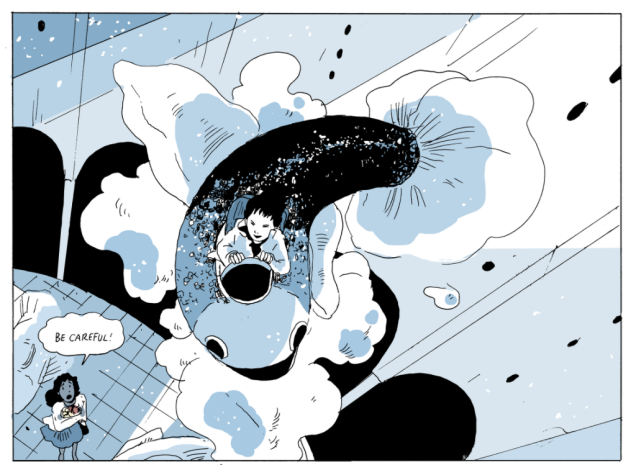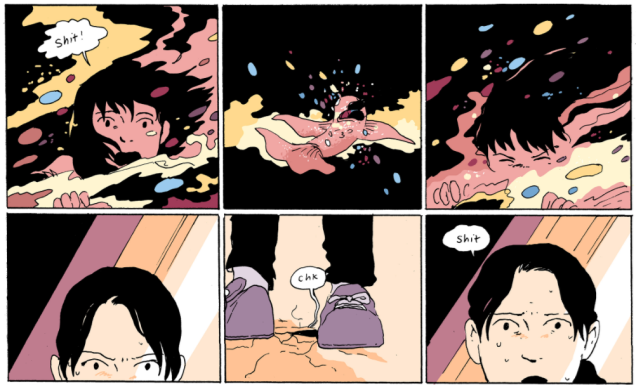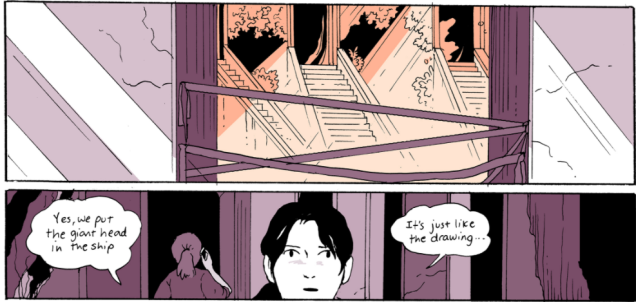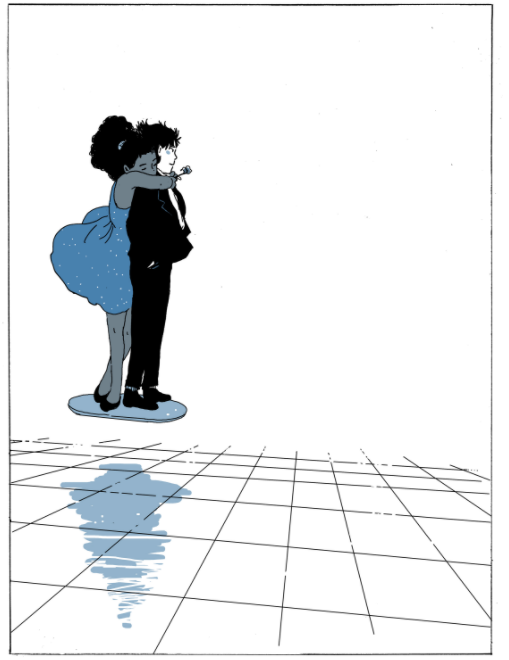
Tillie Walden is a name you should – and this is an imperative – become familiar with instantly. Her gentle, easy lines are so well-trained and nurtured that her art evokes a calmness no matter the subject. Dream-like and full of abandon, it is the perfect style for reflections upon youth and childhood, and this seems to be a theme of many of Walden’s comics and graphic novels.
And how is this achieved? It seems childhood, especially in On A Sunbeam (Walden’s webcomic, which is also going to be coming out as a physical copy very soon I believe), is associated with a resistance to gravity. For the protagonist Mia, flying, jumping and hover-boarding her way through her childhood, these things represent her innocence, and often, her recklessness. Jumping between stories of her past at school, and her present, Tillie shows that Mia is holding onto something from her past:- there are certain threads that are holding fast, and therefore, certain unresolved business.
When Mia is doing something reckless in the present,we jump back to a similar, comparative moment from her school years:

High-school Mia is suffering the consequence of stealing one of the school flying machines, and young adult Mia has just trespassed into an area of a planet where she knows she should not be: an ‘unstable’ area. The focus in the bottom left panel on Mia’s forehead makes us imagine that she had mentally travelled back in time to the previous incident; showing the interconnectedness of these events and also her irresolutions. This juxtaposition of past and present, separated by time but unified both by Walden’s colour scheme and the fear of an instantly regretful Mia, perhaps also brings to focus the ‘prospective’ nature of childhood.
According to Aristotlean ideology, a lot of the value gained through our childhood experiences, are not valuable in and of themselves, but through aiding the transition into adulthood. Here, the juxtaposition allows us to see how Mia’s earlier curiosity and intrigue permeate through into her older self. However, in both cases, this leads Mia into a rather risky situation. Not so much a delayed value then, but perhaps it is some part of childhood Mia has maintained through adolescence, something more valuable in itself and (often) exclusive to childhood: such as the feelings of a lack of responsibility, the opportunity for unstructured play, and – as already mentioned – a certain childish intrigue (Matthews, Mullin). There is definitely something more than this Aristotelian notion of ‘prospective’ value being expressed.
In both cases, Mia exhibits her autonomy to follow her emotive motivations. She wants to ride the flying machine. She wants to explore the beautiful new area. Both of these have restrictions, but these are ignored.

The colour palette seen from behind the tape shows us that another time is being recalled, and the dialogue confirms that Mia is remembering something from her past. In this remembering, she reverts back to her childhood abandon, her lack of concern for her consequences and lack of responsibility.
In a graphic novel set in space, Mia’s jumping, flying, falling, are all expressions of her momentary resistances to gravity, to nature. She flies on the flying machines without permission, she knows the short-cuts to restricted areas in school which involve jumping from one place to another, and, after suffering loss, she takes to the skies with a crew onboard a larger ship…

These are visible signs of autonomy; actions that show freedom, of movement, of expression, of doing what you want. People don’t jump whilst in a passive state, they don’t fly by chance and they certainly don’t hover accidentally. Mia does these to express childhood innocence, and the freedom this gives her: to rebel, to be passionate, and to ignore the future responsibilities.
Or, perhaps, not to ignore responsibility in a negative way as early philosophers liked to claim children do, but to possess a freedom from them. This would shift the image of childhood more so that it reflects Dewey’s conception. Here, the child is not simply awaiting ‘monitors, minders and corruptors’ (Tesar, 2016), but is a being with individual agency, who should be encouraged to play and explore.
I really don’t want to spoil anything about this amazing story, but I want to show you a moment when Mia fully embraced this freedom, maybe at the very point she first felt a nagging of the responsibilities to come – which makes it even more poignant. Here, Mia has just received bad results in the final exams at her school. Despite this, she plans to take the girl she fancies to the school party and, in doing so, she defies gravity in the most unabashed way. With this act, she destroys time, she forgets the future (to which we are all naturally gravitating), and she is guided by passion and innocence and a belief in the suspended now.

- On a Sunbeam by Tillie Walden (http://www.onasunbeam.com/)
- Tillie Walden website (http://www.tilliewalden.com/home)
- Matthews, Gareth and Mullin, Amy, “The Philosophy of Childhood”, The Stanford Encyclopedia of Philosophy (Spring 2015 Edition), Edward N. Zalta (ed.)(https://plato.stanford.edu/entries/childhood/#GooChi)
-
Tesar, Marek; Rodriguez, Sophia; Kupferman, David W, ‘Philosophy and pedagogy of
childhood, adolescence and youth’ in Global Studies of Childhood Volume: 6 Issue 2 (2016) ISSN: 2043-6106 Online ISSN: 2043-6106